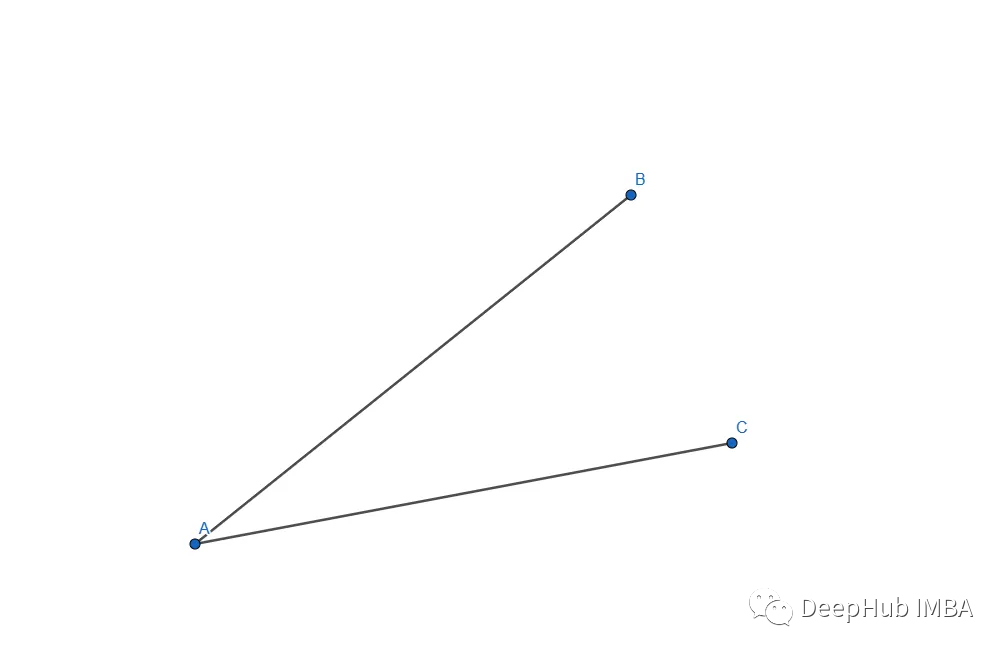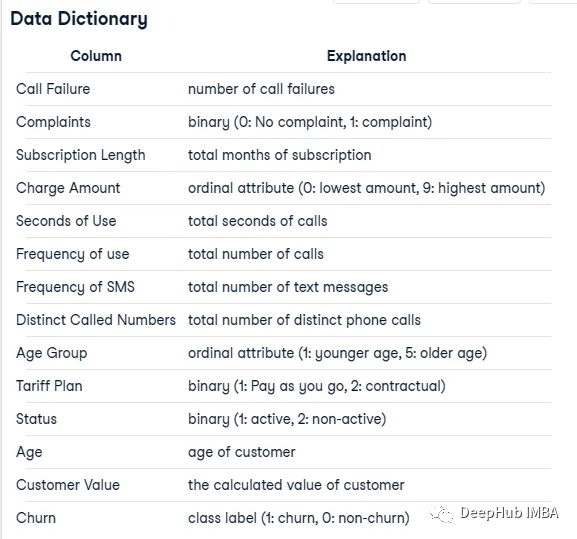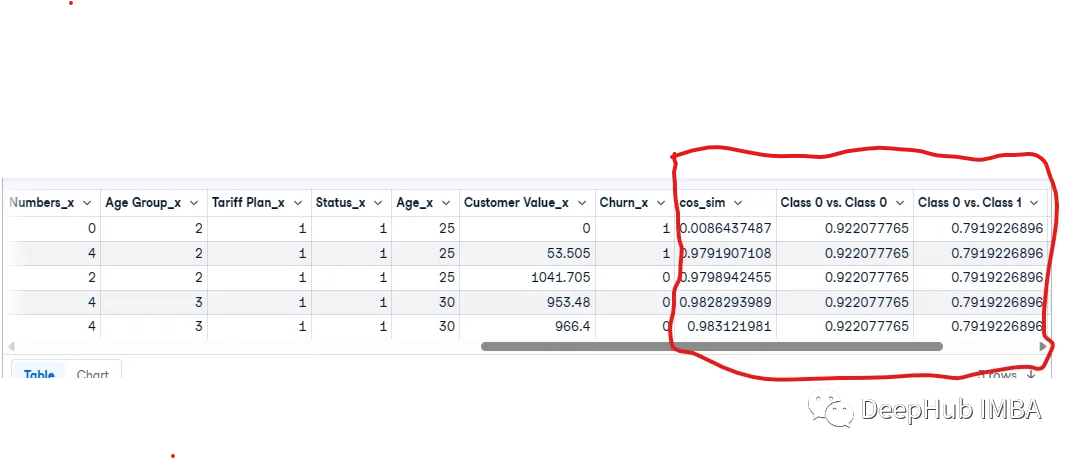余弦相似性是一种用于计算两个向量之间相似度的方法,常被用于文本分类和信息检索领域。具体来说,假设有两个向量A和B,它们的余弦相似度可以通过以下公式计算:

其中,dot_product(A, B)表示向量A和B的点积,norm(A)和norm(B)分别表示向量A和B的范数。如果A和B越相似,它们的余弦相似度就越接近1,反之亦然。

数据集
我们这里用的演示数据集来自一个datacamp:
这个数据集来自一家伊朗电信公司,每一行代表一个客户一年的时间。除了客户流失标签,还有客户活动的信息,比如呼叫失败和订阅时长等等。我们最后要预测的是这个客户是否流失,也就是一个二元分类的问题。
数据集如下:
import pandas as pd
df = pd.read_csv("data/customer_churn.csv")

我们先区分训练和验证集:
from sklearn.model_selection import train_test_split
# split the dataframe into 70% training and 30% testing sets
train_df, test_df = train_test_split(df, test_size=0.3)
SVM
为了进行对比,我们先使用SVM做一个基础模型
fromsklearn.svmimportSVC
fromsklearn.metricsimportclassification_report, confusion_matrix
# define the range of C and gamma values to try
c_values= [0.1, 1, 10, 100]
gamma_values= [0.1, 1, 10, 100]
# initialize variables to store the best result
best_accuracy=0
best_c=None
best_gamma=None
best_predictions=None
# loop over the different combinations of C and gamma values
forcinc_values:
forgammaingamma_values:
# initialize the SVM classifier with RBF kernel, C, and gamma
clf=SVC(kernel='rbf', C=c, gamma=gamma, random_state=42)
# fit the classifier on the training set
clf.fit(train_df.drop('Churn', axis=1), train_df['Churn'])
# predict the target variable of the test set
y_pred=clf.predict(test_df.drop('Churn', axis=1))
# calculate accuracy and store the result if it's the best so far
accuracy=clf.score(test_df.drop('Churn', axis=1), test_df['Churn'])
ifaccuracy>best_accuracy:
best_accuracy=accuracy
best_c=c
best_gamma=gamma
best_predictions=y_pred
# print the best result and the confusion matrix
print(f"Best result: C={best_c}, gamma={best_gamma}, accuracy={best_accuracy:.2f}")
print("Confusion matrix:")
print(confusion_matrix(test_df['Churn'], best_predictions))

可以看到支持向量机得到了87%的准确率,并且很好地预测了客户流失。
余弦相似度算法
这段代码使用训练数据集来计算类之间的余弦相似度。
importpandasaspd
fromsklearn.metrics.pairwiseimportcosine_similarity
# calculate the cosine similarity matrix between all rows of the dataframe
cosine_sim=cosine_similarity(train_df.drop('Churn', axis=1))
# create a dataframe from the cosine similarity matrix
cosine_sim_df=pd.DataFrame(cosine_sim, index=train_df.index, columns=train_df.index)
# create a copy of the train_df dataframe without the churn column
train_df_no_churn=train_df.drop('Churn', axis=1)
# calculate the mean cosine similarity for class 0 vs. class 0
class0_cosine_sim_0=cosine_sim_df.loc[train_df[train_df['Churn'] ==0].index, train_df[train_df['Churn'] ==0].index].mean().mean()
# calculate the mean cosine similarity for class 0 vs. class 1
class0_cosine_sim_1=cosine_sim_df.loc[train_df[train_df['Churn'] ==0].index, train_df[train_df['Churn'] ==1].index].mean().mean()
# calculate the mean cosine similarity for class 1 vs. class 1
class1_cosine_sim_1=cosine_sim_df.loc[train_df[train_df['Churn'] ==1].index, train_df[train_df['Churn'] ==1].index].mean().mean()
# display the mean cosine similarities for each pair of classes
print('Mean cosine similarity (class 0 vs. class 0):', class0_cosine_sim_0)
print('Mean cosine similarity (class 0 vs. class 1):', class0_cosine_sim_1)
print('Mean cosine similarity (class 1 vs. class 1):', class1_cosine_sim_1)
下面是它们的余弦相似度:

然后我们生成一个DF
importpandasaspd
# create a dictionary with the mean and standard deviation values for each comparison
data= {
'comparison': ['Class 0 vs. Class 0', 'Class 0 vs. Class 1', 'Class 1 vs. Class 1'],
'similarity_mean': [class0_cosine_sim_0, class0_cosine_sim_1, class1_cosine_sim_1],
}
# create a Pandas DataFrame from the dictionary
df=pd.DataFrame(data)
df=df.set_index('comparison').T
# print the resulting DataFrame
print(df)

下面就是把这个算法应用到训练数据集上。我取在训练集上创建一个sample_churn_0,其中包含10个样本以的距离。
# create a DataFrame containing a random sample of 10 points where Churn is 0
sample_churn_0=train_df[train_df['Churn'] ==0].sample(n=10)
然后将它交叉连接到test_df。这将使test_df扩充为10倍的行数,因为每个测试记录的右侧有10个示例记录。
importpandasaspd
# assume test_df and sample_churn_0 are your dataframes
# add a column to both dataframes with a common value to join on
test_df['join_col'] =1
sample_churn_0['join_col'] =1
# perform the cross-join using merge()
result_df=pd.merge(test_df, sample_churn_0, on='join_col')
# drop the join_col column from the result dataframe
result_df=result_df.drop('join_col', axis=1)
现在我们对交叉连接DF的左侧和右侧进行余弦相似性比较。
importpandasaspd
fromsklearn.metrics.pairwiseimportcosine_similarity
# Extract the "_x" and "_y" columns from the result_df DataFrame, excluding the "Churn_x" and "Churn_y" columns
df_x=result_df[[colforcolinresult_df.columnsifcol.endswith('_x') andnotcol.startswith('Churn_')]]
df_y=result_df[[colforcolinresult_df.columnsifcol.endswith('_y') andnotcol.startswith('Churn_')]]
# Calculate the cosine similarities between the two sets of vectors on each row
cosine_sims= []
foriinrange(len(df_x)):
cos_sim=cosine_similarity([df_x.iloc[i]], [df_y.iloc[i]])[0][0]
cosine_sims.append(cos_sim)
# Add the cosine similarity values as a new column in the result_df DataFrame
result_df['cos_sim'] =cosine_sims
然后用下面的代码提取所有的列名:
x_col_names = [col for col in result_df.columns if col.endswith('_x')]
这样我们就可以进行分组并获得每个test_df记录的平均余弦相似度(目前重复10次),然后在grouped_df中,我们将其重命名为x_col_names:
grouped_df = result_df.groupby(result_df.columns[:14].tolist()).agg({'cos_sim': 'mean'})
grouped_df = grouped_df.rename_axis(x_col_names).reset_index()
grouped_df.head()
最后我们计算这10个样本的平均余弦相似度。
在上面步骤中,我们计算的分类相似度的df是这个:

我们就使用这个数值作为分类的参考。首先,我们需要将其交叉连接到grouped_df(与test_df相同,但具有平均余弦相似度):
cross_df = grouped_df.merge(df, how='cross')
cross_df = cross_df.iloc[:, :-1]
结果如下:

最后我们得到了3列:Class 0 vs. Class 0, and Class 0 vs. Class 1,然后我们需要得到类之间的差别:
cross_df['diff_0'] = abs(cross_df['cos_sim'] - df['Class 0 vs. Class 0'].iloc[0])
cross_df['diff_1'] = abs(cross_df['cos_sim'] - df['Class 0 vs. Class 1'].iloc[0])
预测的代码如下:
# Add a new column 'predicted_churn'
cross_df['predicted_churn'] = ''
# Loop through each row and check the minimum difference
for idx, row in cross_df.iterrows():
if row['diff_0'] < row['diff_1']:
cross_df.at[idx, 'predicted_churn'] = 0
else:
cross_df.at[idx, 'predicted_churn'] = 1
最后我们看看结果:
grouped_df__2 = cross_df.groupby(['predicted_churn', 'Churn_x']).size().reset_index(name='count')
grouped_df__2['percentage'] = grouped_df__2['count'] / grouped_df__2['count'].sum() * 100
grouped_df__2.head()

可以看到,模型的准确率为84.25%。但是我们可以看到,他的混淆矩阵看到对于某些预测要比svm好,也就是说它可以在一定程度上解决类别不平衡的问题。
总结
余弦相似性本身并不能直接解决类别不平衡的问题,因为它只是一种计算相似度的方法,而不是一个分类器。但是,余弦相似性可以作为特征表示方法,来提高类别不平衡数据集的分类性能。本文只是作为一个样例还有可以提高的空间。
本文的数据集在这里:(需要注册)
https://www.datacamp.com/workspace/datasets/dataset-r-telecom-customer-churn
如果你有兴趣可以自行尝试。
作者:Ashutosh Malgaonkar
x